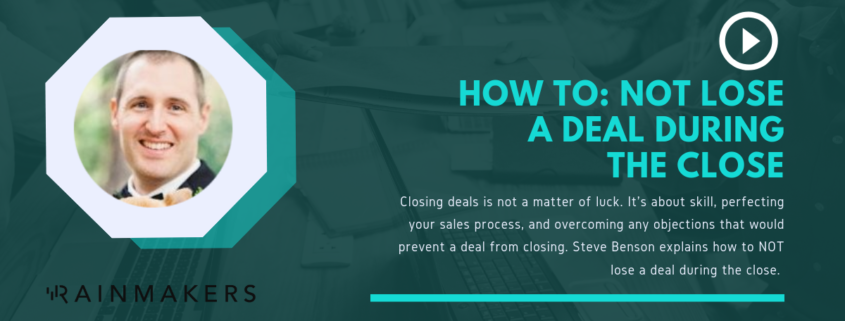[Sales Class] How to Not Lose a Deal During the Close – A Lesson by Steve Benson
Closing deals is not a matter of luck, it’s about skill, perfecting your sales process, and overcoming any objections that would prevent a deal from closing.
According to Steve Benson, it’s the salesperson’s primary job to uncover the real reason why people are unsure about what you are trying to sell them. He explains to not let a prospect take time to “think about it” and attempt to follow up with them next week. Mastering how to avoid these “soft rejections” is a must for closing more deals and you need to gauge their interest in the moment and figure out what information they need to hear to better understand the value of your product.
What a prospect is hesitant on can be one of three things, says Steve. First, ask them specifically what they are uncomfortable or unsure about — once you get a better understanding of what they are truly thinking, you can re-engage and go deeper with them on the issue.
All types of hesitation typically fall into the following three buckets: Fit, Functionality, and Finance.
- Fit: Give them a free trial or a demo of your product being used in an environment or with a product that is similar to your lead’s product or environment. Introduce them to a company that is already using your product and make a comparison for how it can be useful to them too.
- Functionality: If they say they aren’t sure if it will work for them at their unique company, they may believe there is a risk that your product won’t work for them or their business. Uncover what they think the functionality risk is and then overcome the objection. They could be worried the product doesn’t work and need to see a demo. Or they could be worried about implementation and that their employees/customers won’t use the product – show other companies implementing the product. Provide references and case studies of other companies using the product successfully.
- Finance: “This seems too expensive for me.” To overcome this, find out the real objection behind the price objection, since price might not be the real reason. Find out if they don’t think your product is valuable and help them add up the value to show them that your price is fair. Another tip is to show them the cost of not using your product, or how your product will save them time and money.
You may find that a prospect’s concerns fall into several of these categories. Try to narrow down what the primary objection is and focus on educating them in order of what is most important until all of their questions are fully answered. From there, you can continue discussing your service offerings and pricing.
Steve’s Steps to Overcoming A “Soft No.”
- Gauge interest
- Uncover true objection
- Overcome objection
- Ask questions like “if I can prove to you that you can master the product within a week, would you buy the product?
Through your questions and by reading into the prospects answers, you can uncover additional objections and address them as needed. Remember to include why your product is a good fit, how it will function properly to fit their business needs, and why it is a smart financial decision to use your product.




